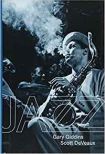Jazz by Gary Giddins and Scott Deveaux
| Jazz by Gary Giddins and Scott Deveaux | |
|
| |
| Category: Entertainment | |
| Reviewer: John Van der Kiste | |
| Summary: A full history of jazz from its 19th century roots to the present day. Throughly readable, with several appendices including a select discography, it will also serve as an excellent work of reference. | |
| Buy? Yes | Borrow? Yes |
| Pages: 720 | Date: November 2009 |
| Publisher: W W Norton and Co | |
| ISBN: 978-0393068610 | |
|
| |
At first glance this 700-page volume might look a little daunting. Do not be daunted. If you want a small pocket book which merely scratches at the surface and can probably be digested in a sitting or two, look elsewhere. On the other hand, if you want an extremely readable and comprehensive book on jazz which can not only be read cover to cover, but also retained as a work of reference to use again and again, I doubt if this can be bettered.
I write as somebody who has been passionate about pop and rock music since the rise of Beatlemania, yet is fascinated by the history of jazz (as well as classical and other genres) and its main practitioners, even if it will never be my first musical love, and has a musical ear of sorts even if I have never yet learned to 'read the dots'.
As the authors stress in their introduction, this book does not require musical knowledge or ability, and it is not an encyclopedia. The first 600 pages or so begin with a look at the elements and instruments of jazz, rhythm, melody and scales, and at the structures of jazz form and improvisation. A more or less chronological history of the music then follows, from its origins in the spiritual folk and blues genres of the late 19th century to the fusion, acid jazz and other offshoots of the present day. There are regular diversions in the form of mini-biographies of its main practitioners, from Bessie Smith, Louis Armstrong, Duke Ellington and Bix Beiderbecke to Thelonious Monk, Miles Davis, Sarah Vaughan and Herbie Hancock. In addition, the authors put several seminal jazz recordings under the microscope, providing a detailed, virtually second-by-second analysis and description of the music.
This is followed by a glossary of selected singers and musicians on primary jazz instruments, a glossary, a section on collecting jazz recordings (including an essential discography listing 101 albums or collections), and a directory of jazz on film.
One of the book's most telling points is the statement that No musical form grows in a cultural vacuum. It has always borrowed from other forms (blues and jazz could never be put into separate pigeonholes), and as saxophonist Dexter Gordon once said, it is an octopus - it will take whatever it needs or can use. Certain artists who may not be strictly considered as belonging to the genre, such as Bing Crosby, Frank Sinatra, Nat King Cole and Ray Charles, are all given due consideration.
I also like the way in which the authors examine the relationship between the jazz world and its external musical and historical influences. There are several paragraphs about the development of electrical recording in 1925, which was largely responsible for the widespread development of the 78 rpm disc and of radio across America, and a few pages later about the economic depression which came close to destroying the record companies, with sales of discs plunging disastrously between 1929 and 1933. Some twenty years on, we read about the effect that rock'n'roll and 'the new barbarians' – Elvis Presley, Chuck Berry, and a little later the Beatles and the Rolling Stones - had on the music industry which jazz had previously regarded as its own. Contrary to what some musicians had feared, it was not all over for them. Chick Corea, Blood Sweat & Tears and Jason Moran, among others, proved that there was life for jazz after rock, and surely always will be.
This book is a first-class read, and I can see it remaining a standard work for some time to come.
Our thanks to Norton for sending a copy to Bookbag.
In similar vein, and on another not dissimilar form, may we also recommend Delta Blues by Ted Gioia.
Please share on: ![]() Facebook,
Facebook, ![]() Twitter and
Twitter and
![]() Instagram
Instagram
![]() You can read more book reviews or buy Jazz by Gary Giddins and Scott Deveaux at Amazon.co.uk Amazon currently charges £2.99 for standard delivery for orders under £20, over which delivery is free.
You can read more book reviews or buy Jazz by Gary Giddins and Scott Deveaux at Amazon.co.uk Amazon currently charges £2.99 for standard delivery for orders under £20, over which delivery is free.
![]() You can read more book reviews or buy Jazz by Gary Giddins and Scott Deveaux at Amazon.com.
You can read more book reviews or buy Jazz by Gary Giddins and Scott Deveaux at Amazon.com.
Comments
Like to comment on this review?
Just send us an email and we'll put the best up on the site.


